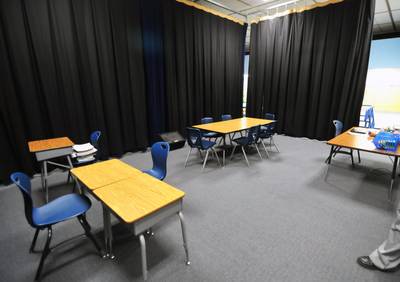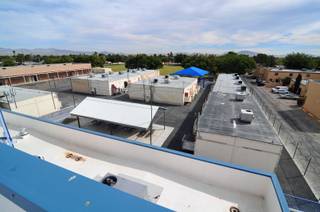Tuesday, Oct. 15, 2013 | 2 a.m.
Paul Takahashi and Kyle B. Hansen
Related story
Billie Ann Watanabe barely has any space to walk around in her portable classroom.
The Ronzone Elementary School fifth-grade teacher has 33 students crammed into a windowless trailer sitting on the school’s blacktop.
As she begins teaching her English lesson, Watanabe carefully maneuvers herself around several rows of students.
“I can’t walk around the room without bumping into a kid’s arm,” Watanabe said later. “The space, it’s just too small.”
An estimated 1 in 5 Clark County elementary school students goes to class every day in a portable classroom.
The classrooms, which are housed in either a single or double-wide mobile home-like trailer, were designed to be temporary structures — used, for example, when the main school building was undergoing renovations.
But as enrollment continues to climb in the nation’s fifth-largest school district, portable classrooms have become a fact of school life in Southern Nevada.
The Clark County School District has 1,282 portable classrooms spread across its 217 elementary school buildings. If all of the portables were converted into classrooms in permanent buildings, the School District would have the equivalent of nearly 40 additional elementary schools.
Anticipating an influx of more elementary school students and a new state-mandated cap on kindergarten class sizes, the School District is planning to purchase up to 100 more portable classrooms over the next two years.
The addition of yet more portables has some teachers and district leaders concerned about whether portable classrooms provide an adequate learning environment.
“If I had my way, we would not have portable classrooms. We would have actual buildings for these kids,” School Board member Deanna Wright said. “I personally feel that this is not the best we can do for our kids. I don’t think any of us think this is acceptable.”
• • •
In the past few years, School District leaders have called attention to the myriad facilities problems at many of the district's 357 schools.
There are failing air-conditioning and heating systems, crumbling roofs and schools without the proper electrical infrastructure to support all the technology necessary to provide a 21st-century education.
Another growing concern among educators is the School District’s increasing reliance on portables to alleviate crowded classrooms.
In 1998, when voters approved a school bond program that ultimately raised $4.9 billion for capital improvements, the School District had 771 portable classrooms at the elementary, middle and high school levels.
Fifteen years later, the district has more than doubled its number of portables to 1,663.
For the most part, portable classrooms are being used to cope with the district’s growth over the past two decades. Since 1998, the school district added more than 100,000 students, led in part by an influx of Hispanic and Asian students, growing by more than a third.
This year, the School District posted a record enrollment of 149,515 elementary students, pushing elementary campuses to an estimated 15 percent over capacity. Not surprisingly, elementary campuses have the vast majority of the district’s portables for use as classrooms.
(Some elementary schools use portables to house specialist offices, such as for speech therapists, and wraparound services, such as a food pantry. Most middle and high schools use portables for specialty programs, such as in-school disciplinary programs for misbehaving students.)
The average Las Vegas Valley elementary school has about six portable classrooms, but some schools can have up to 20 portables on campus.
About three quarters of the valley’s elementary schools have at least one portable. Nearly a quarter of them — 52 campuses — have more than 10 portables.
These “portable cities” or “portable lands,” as they are colloquially known, have become ubiquitous as the district struggles to find money to build new schools and additions.
• • •
Not that long ago, the School District was flush with property tax receipts from a booming economy. It was able to build new schools to accommodate enrollment growth, which at one point was the fastest in the country.
Since 1998, Clark County built more than 100 new schools and hired thousands of new teachers. The Great Recession, however, hit Las Vegas hard. Tax revenues to pay for capital improvements dried up, along with the economy.
Although the district was able to hire nearly 1,800 more teachers this year because of additional state and local funding, the district is running out of capital funds. The district estimates it has $669 million in facility needs but only $44 million left from the 1998 bond program.
In November 2012, the School District sought voter approval for a tax initiative that in part would have funded construction of two new elementary schools in the southwest valley and the replacement of two older elementary schools. Each new elementary school costs the district about $25 million to construct.
Voters, though, rejected the ballot measure by a margin of 2-to-1.
Without additional capital funding, the School District has limited options to address student crowding. It could rezone thousands of students or convert up to 65 elementary schools to a year-round schedule.
The School Board is also considering asking voters for more capital money, either in 2014 or 2016, to help the district fix and build more schools.
Something must be done because enrollment is expected to keep growing. As Las Vegas rebounds from the recession, housing developers are building again in Summerlin, Henderson and the southwest valley.
“I see what’s coming, and it’s just going to get worse and spread in other areas,” district demographer Rick Baldwin said. “It’s not stopping.”
• • •
Meantime, the School District plans to keep adding portables.
However, there’s only so much space on a school property. At some point, without any new money for campus construction, existing schools simply will run out of space for the “temporary” classrooms.
Last year, taking a page out of California’s book on dealing with school crowding, the School Board considered creating new elementary schools entirely out of modular portable classrooms.

Ronzone Elementary School, located in the central Las Vegas Valley, has 20 portable classrooms and uses the backstage section of its central auditorium as a classroom for high-achieving students. Across the district, there are more than 1,200 portable classrooms serving about a fifth of all elementary school children.
However, that plan is now off the table. That’s because beginning next year, Nevada lawmakers have mandated kindergarten classes have no more than 21 students for every teacher. The requirement will likely require more kindergarten classes.
The district still doesn’t have enough portables to handle the overflow of students, officials said. Plans are to purchase up to 50 new portables each quarter for the next two years to handle the overflow of students.
Each new portable unit will cost upwards of $50,000, excluding the cost of installation and moving, which adds at least an additional $20,000 per unit.
The portables are cheaper than building new schools and additions, but the temporary structures are designed for a lifespan of about 20 years. Many of the district’s portables have exceeded that lifespan, causing some teachers to complain about leaking roofs, musty smells and mold.
A 2004 report on hundreds of portables in California — the largest federal study of its kind — found several environmental problems with portables, including improper levels of ventilation, lighting, noise and pollution.
Clark County officials maintain portable classrooms are safe for students.
Schools are not allowed to place kindergarten and special-needs students in portables because of safety concerns, particularly around those students climbing steps to enter the portable.
District officials also discourage putting first- and second-grade students in portables because of safety concerns about having younger students commuting alone between the portable and school building to use the bathroom.
These rules, however, pose a conundrum for elementary principals.
Because of class-size reduction plans, kindergarten, first- and second-grade classes are generally smaller than third-, fourth- and fifth-grade classes. This means younger students must be placed inside the school building, which tends to have larger classrooms. Upper-grade classes, which can approach 30 students, are relegated to the smaller portable classrooms.
• • •
Four Clark County elementary schools have the highest number of portables: 20.
Ronzone Elementary is one of those four schools, but it has the unique distinction of being the most crowded school in the district at 81 percent over capacity, according to officials.
The central valley elementary school, built in 1965, was designed for a capacity of 635 students. This year, 1,045 students are enrolled at Ronzone.
Despite additions — new computer labs, art rooms, cafeteria and library — built into the school since 2005, Ronzone’s blacktop is overflowing with portable classrooms.
In the past two years, the school added four portables, eating up former foursquare and hopscotch areas. If Ronzone continues to grow, the district is considering tearing down a shade structure to make more space to add portables.
Currently, about 600 kindergarten through second-grade students are in the school building, and about 400 third-, fourth- and fifth-grade students are in portables. Soon, however, Ronzone may have more students in portables than in the actual school building.
That doesn’t faze Principal Becky Tschinkel, who has been at Ronzone for five years. She is adamant her students, many of them English-language learners, will thrive.
“We still have great instruction going on, no matter what four walls surround them,” Tschinkel said. “We don’t look at having portables as a negative. We care more about having lower class sizes and getting quality teachers in front of our kids.”
Ronzone educators have had to adapt to portable classrooms.
Although Ronzone teachers generally like being able to control the cooling and heating in individual portable classrooms, they generally dislike being separated from the main school building.
Balls bounce off the exteriors of portable classrooms during gym classes, and outside noises permeate the portables’ thin walls. The portables also don’t have the amenities of their in-school counterparts: windows, sinks and ceiling-mounted digital projectors that save floor space.
Some Ronzone teachers in portables have done away with their own desks to give students more space. Teacher desks and excess furniture from the portables fill four large shipping container boxes that sit on the side of the school’s field.
Instead of desktop computer stations, which take up more space, Ronzone is purchasing laptop and tablet computers for its students in portables.
In addition, the school schedule is meticulously planned, down to which class uses which hallways and ramps, to control student traffic around campus. The school uses every space it has, even the school’s auditorium-like “pit,” which serves as a classroom for gifted and talented students.
“We make it work by thinking outside the box,” Tschinkel said. “We work with what we can control. The portables are beyond our control.”


Join the Discussion:
Check this out for a full explanation of our conversion to the LiveFyre commenting system and instructions on how to sign up for an account.
Full comments policy